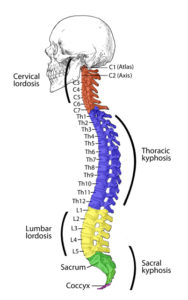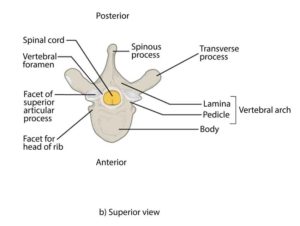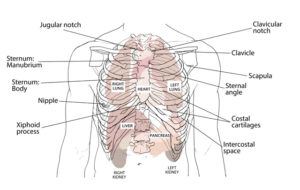Unfortunately, in the first printing of Your Spine, Your Yoga there were 3 cases where an illustration was in error, and a few other instances of typographical errors. These are listed below:
Errors in figures:
Figure 3.13 on page 13: the label beside C2 which reads “atlas” should read “axis”.

Figure 3.18 on page 19: the label “vertebra” at the far right of the right figure should read “vertebral arch”

Figure 3.302 on page 190: The labels at the bottom of the drawing which say “Right lung” and “Left lung” should say “Right kidney” and “Left kidney”.

Text errors:
Page 7: “Is dropping back from standing into the Wheel Pose (Dhanurasana), as shown in figure 3.6, a good idea?” should read “Is dropping back from standing into the Wheel Pose (Urdhvadhanurasana), as shown in figure 3.6, a good idea?”
Page 13: There should be a footnote after “Fortunately, we can rely on the fact that the cervical spine has seven and only seven vertebrae, which is the same number for all mammals (even the giraffe!).” The footnote should read: “Well, almost all! To be exact, the manatee has 8 cervical vertebrae and some sloths may have anywhere from 5 to 8 cervical vertebrae. Even some humans have been shown to have an eighth cervical vertebrae, but this is very rare. See Frietson Galis, “Why do almost all mammals have seven cervical vertebrae? Developmental constraints, How genes and Cancer,” Journal of Experimental Zoology 285 (1999): 19-26.
Page 14: Table 3.1 heading which reads “TOTAL NUMBER OF THORACIC AND LUMBAR VERTEBRAE” should read “TOTAL NUMBER OF PRESACRAL VERTEBRAE”.
Page 101: “This would be the student in figure 3.134c,” should read “This would be the student in figure 3.133c,”.
Page 118: “The orientations of the lumbar facets are often asymmetric, with the right side being different than the left” should read “The orientations of the lumbar facets are sometimes asymmetric, with the right side being different than the left”. On page 26 it was stated that, “asymmetry in type lumbar facets is most likely due to a pathology, as asymmetry there is not normal.” The sentence on page 118 is from the Gray’s Anatomy 39th edition, page 749, where they say, “The facets are sometimes asymmetrical.” However, a more definitive statement is found in Youssef Masharawi 2004, “Asymmetry in facet orientation is a normal characteristic in most thoracic vertebrae but not in the lumbar ones”. Masharawi goes on to say “Asymmetry in facet orientation is a normal feature of the human spine. The current study indicates that right thoracic facets are more vertically and frontally oriented than the left ones. This information questions the proposed association between asymmetry in facet orientation and degenerative changes in the spine, as asymmetry is the normal state of the thoracic spine. It is reasonable to suggest, however, that when asymmetry in facet orientation occurs in lumbar vertebrae (that are normally symmetric), it may be related to pathologic conditions.” [Masharawi Y, Rothschild B, Dar G, Peleg S, Robinson D, Been E, Hershkovitz I. Facet orientation in the thoracolumbar spine: three-dimensional anatomic and biomechanical analysis. Spine (Phila Pa 1976). 2004 Aug 15;29(16):1755-63. doi: 10.1097/01.brs.0000134575.04084.ef. PMID: 15303019.]
Page 136: “A moment arm is the distance from the center of the force, times the perpendicular distance between the force and its axis of rotation…” should read “A moment arm is the product of the force times the perpendicular distance between the force and its axis of rotation…”
Page 163: In the It’s Important box, the Sanskrit name for the Wheel Pose should be Urdhvadhanurasana.
Page 222: Table 3.305 fist column heading which says “LUMBAR MOVEMENT” should read “THORACIC MOVEMENT“.
Page 237: “The rectus capitis anterior and rectus capitis lateralis are very short muscles that reach between the transverse processes of the atlas to the base of the skull in front of and to the side of the foramen magnum, respectively (see figure 3.419)” should read “The rectus capitis anterior and rectus capitis lateralis are very short muscles that reach between the transverse processes of the atlas to the base of the skull in front of and to the side of the foramen magnum, respectively (see figure 3.418).”